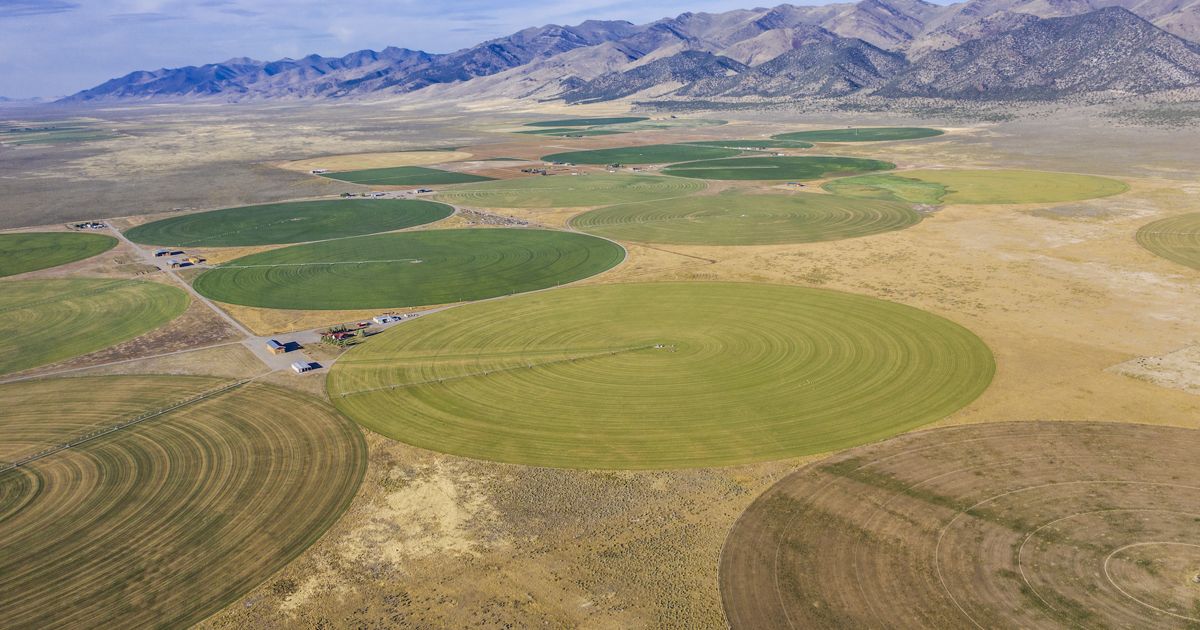New Study Published on Feasibility of Retiring Groundwater Rights Coupled with Agrivoltaics in Diamond Valley
Feasibility Study on Agrivoltaics in Diamond Valley The Nature Conservancy


With proper planning and some additional infrastructure, agrivoltaics and water rights retirement could be beneficial to simultaneously implement in Diamond Valley

In a new report published by The Nature Conservancy (TNC) in partnership with Eureka Conservation District and Eureka County, it has been suggested that with proper planning and additional infrastructure, the implementation of agrivoltaics and water rights retirement could be beneficial in Diamond Valley. The report, titled “Resolving Groundwater Overuse: Feasibility of Agrivoltaics Coupled with Groundwater Rights Retirement,” explores the viability, socioeconomic benefits, and tradeoffs of retiring groundwater rights while implementing agrivoltaics, which refers to the practice of locating agriculture adjacent to or underneath solar panels.
Diamond Valley’s Groundwater Management Plan and the Need for Change
In 2015, Diamond Valley was designated as a Critical Management Area, leading to the development and implementation of a groundwater management plan (GMP) by the community. The goals of the plan include stabilizing groundwater levels, preserving the economy and culture of Diamond Valley, and maximizing viable uses of private land. As part of the GMP, there will be planned reductions in irrigated water use, resulting in some farmland being taken out of production. Stakeholders are now faced with the challenge of ensuring the continued thriving of Diamond Valley’s economy and culture with less water.
The Potential of Groundwater Rights Retirement
Retiring groundwater rights has been considered as a tool for reducing groundwater overuse in Nevada. Laurel Saito, Nevada water strategy director for The Nature Conservancy, explains that Diamond Valley could be a suitable location for voluntary retirement of groundwater rights if a retirement program were to be established. In fact, several water right holders in Diamond Valley have already applied to retire their groundwater rights under the Nevada Water Conservation and Infrastructure Initiative, which is funded by the American Rescue Plan Act. However, it is crucial to consider the future use of the land once irrigation is removed.
Agrivoltaics as a Solution
One possible strategy to achieve multiple goals outlined in the GMP is to retire private property groundwater rights while transitioning formerly irrigated agricultural lands to photovoltaic solar farms. Peter Gower, The Nature Conservancy’s Western U.S. and Canada Division climate and renewable energy director, highlights that renewable energy buildout and water scarcity, particularly groundwater scarcity, are two significant issues in the West. The study explores how agrivoltaics can address both issues while allowing communities to thrive.
The Study’s Phases and Key Findings
The study consisted of two phases: 1) conducting a situation assessment to gather input from affected stakeholders, and 2) examining the technical feasibility of retiring groundwater rights while transitioning agricultural land to solar farms. Some key findings from the report include:
- Groundwater rights retirement: Establishing a fair and robust system to retire groundwater rights is crucial for water conservation. However, limited available data necessitates complex analysis using multiple approaches to determine the valuation of groundwater rights in Diamond Valley.
- Solar development and grid interconnection potential: Diamond Valley receives sufficient sunshine for economically and technologically feasible utility-scale solar development. However, transmission capacity is currently a limiting factor due to existing infrastructure and competing projects, even with the proposed Greenlink North powerline. The terms of a solar lease between landowners and developers play a significant role in protecting landowners from financial risks.
- Agrivoltaics in Diamond Valley: Agrivoltaics can provide income diversification for farmers in Diamond Valley. The soil types currently under irrigation in the valley are well-suited for vegetation that can survive on precipitation alone.
SDGs, Targets, and Indicators
SDGs:
- SDG 6: Clean Water and Sanitation
- SDG 7: Affordable and Clean Energy
- SDG 13: Climate Action
- SDG 15: Life on Land
Targets:
- SDG 6.4: By 2030, substantially increase water-use efficiency across all sectors and ensure sustainable withdrawals and supply of freshwater to address water scarcity and substantially reduce the number of people suffering from water scarcity
- SDG 7.2: By 2030, increase substantially the share of renewable energy in the global energy mix
- SDG 13.1: Strengthen resilience and adaptive capacity to climate-related hazards and natural disasters in all countries
- SDG 15.3: By 2030, combat desertification, restore degraded land and soil, including land affected by desertification, drought, and floods, and strive to achieve a land degradation-neutral world
Indicators:
- Indicator for SDG 6.4: Proportion of water bodies with good ambient water quality
- Indicator for SDG 7.2: Renewable energy share in the total final energy consumption
- Indicator for SDG 13.1: Number of deaths, missing persons, and directly affected persons attributed to disasters per 100,000 population
- Indicator for SDG 15.3: Proportion of land that is degraded over total land area
Analysis:
1. Which SDGs are addressed or connected to the issues highlighted in the article?
The issues highlighted in the article are connected to the following SDGs:
- SDG 6: Clean Water and Sanitation
- SDG 7: Affordable and Clean Energy
- SDG 13: Climate Action
- SDG 15: Life on Land
2. What specific targets under those SDGs can be identified based on the article’s content?
Based on the article’s content, the following specific targets can be identified:
- SDG 6.4: By 2030, substantially increase water-use efficiency across all sectors and ensure sustainable withdrawals and supply of freshwater to address water scarcity and substantially reduce the number of people suffering from water scarcity
- SDG 7.2: By 2030, increase substantially the share of renewable energy in the global energy mix
- SDG 13.1: Strengthen resilience and adaptive capacity to climate-related hazards and natural disasters in all countries
- SDG 15.3: By 2030, combat desertification, restore degraded land and soil, including land affected by desertification, drought, and floods, and strive to achieve a land degradation-neutral world
3. Are there any indicators mentioned or implied in the article that can be used to measure progress towards the identified targets?
Yes, there are indicators mentioned or implied in the article that can be used to measure progress towards the identified targets:
- Indicator for SDG 6.4: Proportion of water bodies with good ambient water quality
- Indicator for SDG 7.2: Renewable energy share in the total final energy consumption
- Indicator for SDG 13.1: Number of deaths, missing persons, and directly affected persons attributed to disasters per 100,000 population
- Indicator for SDG 15.3: Proportion of land that is degraded over total land area
Table: SDGs, Targets, and Indicators
| SDGs | Targets | Indicators |
|---|---|---|
| SDG 6: Clean Water and Sanitation | Target 6.4: By 2030, substantially increase water-use efficiency across all sectors and ensure sustainable withdrawals and supply of freshwater to address water scarcity and substantially reduce the number of people suffering from water scarcity | Indicator: Proportion of water bodies with good ambient water quality |
| SDG 7: Affordable and Clean Energy | Target 7.2: By 2030, increase substantially the share of renewable energy in the global energy mix | Indicator: Renewable energy share in the total final energy consumption |
| SDG 13: Climate Action | Target 13.1: Strengthen resilience and adaptive capacity to climate-related hazards and natural disasters in all countries | Indicator: Number of deaths, missing persons, and directly affected persons attributed to disasters per 100,000 population |
| SDG 15: Life on Land | Target 15.3: By 2030, combat desertification, restore degraded land and soil, including land affected by desertification, drought, and floods, and strive to achieve a land degradation-neutral world | Indicator: Proportion of land that is degraded over total land area |
Behold! This splendid article springs forth from the wellspring of knowledge, shaped by a wondrous proprietary AI technology that delved into a vast ocean of data, illuminating the path towards the Sustainable Development Goals. Remember that all rights are reserved by SDG Investors LLC, empowering us to champion progress together.
Source: nature.org

Join us, as fellow seekers of change, on a transformative journey at https://sdgtalks.ai/welcome, where you can become a member and actively contribute to shaping a brighter future.







